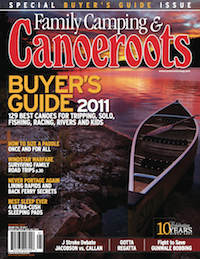James van Nostrand had no grand ambitions when an outfitter from Prince Rupert, B.C., commissioned him to design and build North America’s longest canoe. In fact, the Chilliwack, B.C.-based designer of over 20 boats had his doubts that Seashore Charters’ proposed 65-foot, Pacific Northwest-style canoe would even work.
After studying photographs of a 63-foot Haida dugout built in 1878 and now hanging in the American Museum of Natural History in New York City, van Nostrand became convinced that such a monster would be too awkward to paddle. “It was the depth and flare of the hull,” says van Nostrand, who is best known for shaping most of Abbotsford, B.C.’s Clipper Canoes. “How would you sit there and paddle it comfortably?”
But van Nostrand didn’t give up. His research took him to the Museum of Civilization in Ottawa, where he saw a 57-foot Haida canoe that was built in 1908. The experience was a revelation. Here was a long, sleek craft that was of manageable depth for paddling, he recalls.
“It wasn’t until I met that canoe face-to-face that I knew I could build a 65-footer that would work.”
He set about drafting quarter-scale crosssections of the hull, basing his design on his experience shaping Clipper’s line of 22- to 36-foot Big Canoes.
Over a hectic six-week period concluding in January 2010, van Nostrand and a team of builders transferred his hand-drawn lines to a plywood building form, covered it with thin strips of foam and fiberglassed it inside and out. Off the mold, the 80-inch-wide canoe was finished with thwarts, seats and an on-board inflatable life raft. It was then painted by Metlakatla First Nations artist Mike Epp with the insignias of the four coastal clans: the raven, wolf, orca and eagle.
Christened Ha’nda’wit’waada—the canoe that brings people together—van Nostrand’s canoe does just that. In its inaugural year, groups of up to 48 people from around the world propelled it on day tours along the northern coast of British Columbia.
“It’s been 140 years since canoes this big paddled the coast,” says Seashore Charters guide Peter Loy. “People can really feel the spirit in it.”

This article first appeared in the Spring 2011 issue of Canoeroots Magazine.




